The elements of art form: from basic shapes to human body
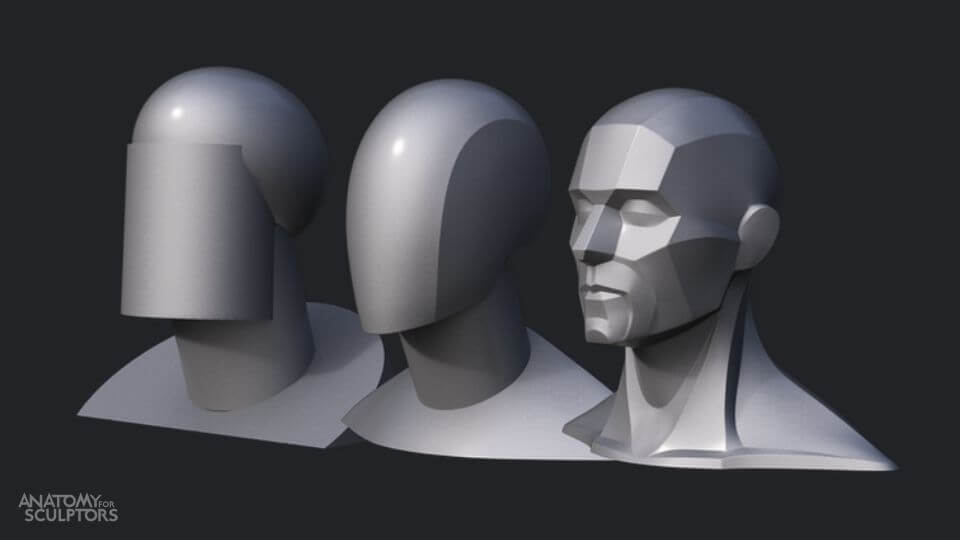
When you analyze the 3D form of the human body, you will notice that its parts can be broken down into smaller elements – basic shapes (think a cone, a cube, a sphere, a cylinder, etc.). All of them can then be rearranged into many different body positions. And voila! Just like that, you’re free from copying and replicating art that already exists. Now you’re free to create your own unique compositions.
In this article you will find out more about the benefits of using basic shapes in your art and learn how to make them work in your favor. We will also explore how to create 3D shapes of muscles and their anatomy.

Learn to use basic shapes to master the chaos of organic forms.
(from “Form of the Head and Neck”, p.7)
Use a basic shapes 3D model or a basic shapes drawing to reach understanding and accuracy
When young artists start a drawing or a reference sketch for a sculpture, it is sometimes hard for them to commit to one line. Even copying an artwork is not always easy. Organic forms are complex and confusing. Your confidence and drawing accuracy take a heavy punch when you don’t understand what you want to create.
That’s why it is better to break form into basic shapes. Working with basic shapes will develop your understanding of the form and it will be an excellent foundation to build on. The extra bonus of basic shapes is that they are very simple to memorize. That will make you more flexible and allow you to think, sculpt, draw, 3D model, and create without hesitation.

From basic shapes to block-outs, to a realistic finish.
(from “Form of the Head and Neck”, p.17)
When picking art subjects to draw, sculpt, or model, adapt your basic shapes
People are very different – our gender, age, body type, ethnicity, and other factors influence our looks. You cannot use the same shapes for every character in your art. Adapt your basic shapes for the subjects you choose to sculpt, draw, or model. For instance, use blocky shapes if you want to achieve a more rigid look for your character and rounder shapes if you want it to have softer features.
How to create 3D shapes of muscles
There are a lot of muscles in the human body. When you see all those bumps under the skin, it might be tempting to try and learn the reason behind each and every one of them. This anatomical knowledge (especially if freshly gained) sometimes leads to artworks with overly emphasized individual muscles. The result is often less like a human figure but more like a model in an anatomy book.
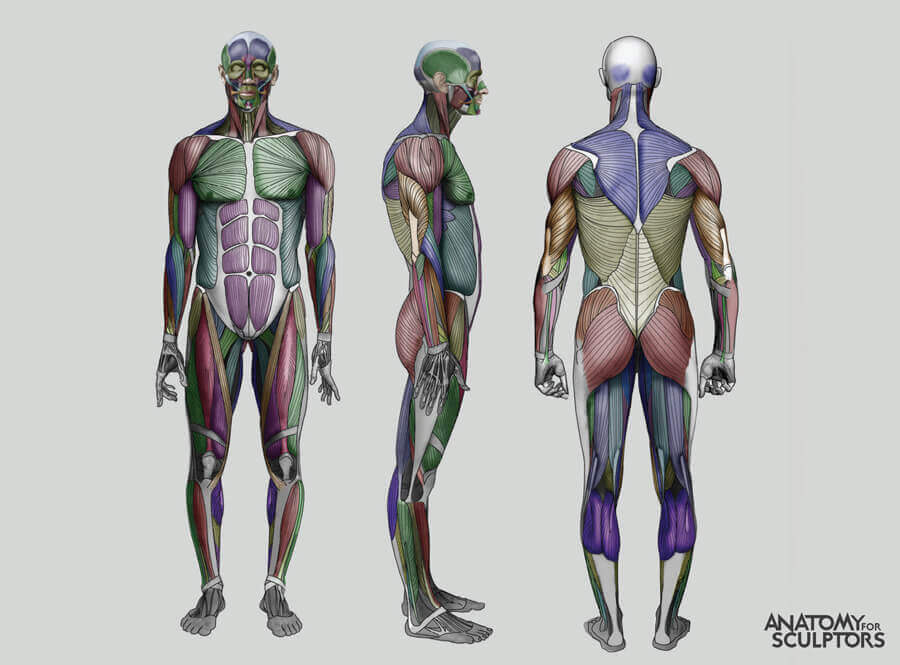
Ecorche is a human figure without the skin. Unless it’s the assignment, you don’t want your artwork to look like this! (from “Anatomy for Sculptors: Understanding the Human Figure”, p.24)
Your main objective is to achieve the illusion of a realistic figure. Instead of thinking about each muscle individually, try to think about simple 3D shapes and volumes these muscles make. For example, neighbor muscles with similar functions can sometimes be banded together in a single form. When the quads of a leg are flexed, they’ll pop out individually, but when relaxed – they’ll become one big, even shape.
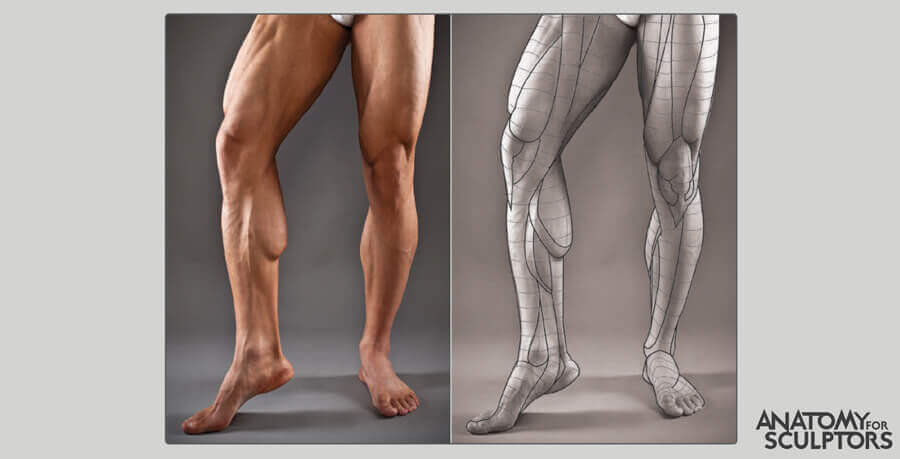
The shape of male legs.
(from “Anatomy for Sculptors: Understanding the Human Figure”, p.195)
Body movement drawing and modeling
When sculpting, drawing, or modeling, don’t make the muscles the focal point. If you include every tendon and muscle you know about in your artwork, it will not make a lot of sense from the movement perspective and won’t look realistic at all.
Focus on the action or the emotion you want to achieve instead. You can start your drawing or your reference sketch for a sculpture with a gesture drawing. (Yes, anatomy only serves as an additional layer to the gesture, it’s not replacing it!) Then add the muscles in a way that makes sense and enhances the action you want to achieve for your figure.
To sum it up – you don’t want people to be looking at individual parts (muscles) in your artwork. You want them to be interested in what the person in your artwork is feeling or what it is about to do.
Sculpting muscles in relation to each other
Some people call it the constipated bodybuilder, some call it the snowman – both are great analogies. Whatever you choose to call it, please don’t sculpt and draw symmetrical arm and leg muscles for your characters!
Each muscle has its origin and insertion points where they attach themselves to the skeleton. The origin is the point where the muscle attaches itself to the more central and stationary part of the body, and the insertion is the point where it binds to the more outer and movable part of the body.
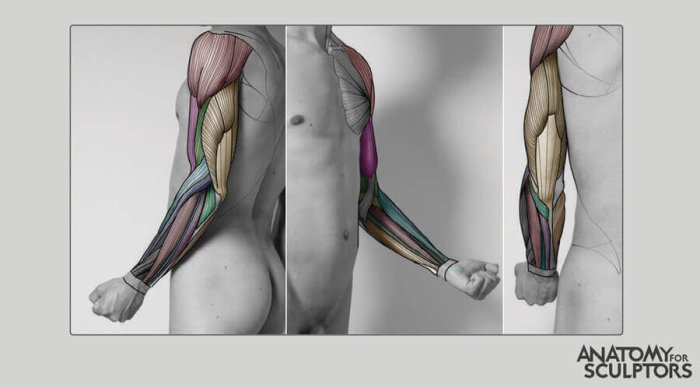
A partially flexed arm with visible bicep and tricep.
(from “Anatomy for Sculptors: Understanding the Human Figure”, p.154)
While muscles are able to contract and pull the insertion towards their origin, they can’t relax by themselves. They need an antagonist muscle to pull them back in the relaxed position. Think about how the bicep flexes the arm and the tricep – straightens it back into its resting position.
The result is that muscles tend to arrange themselves in a kind of a zig-zag along the body. So don’t put the bicep directly opposite to the tricep, which will fuse them into one big lump of awkwardness.
FYI the human skeleton is a great roadmap for muscle placement! Read more about the benefits of knowing the human skeleton in this article.
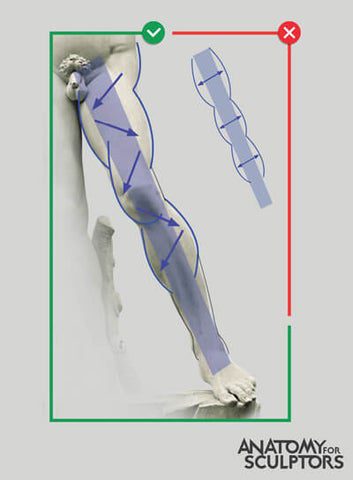
The zig-zag arrangement of muscles along the body.
(from “Anatomy for Sculptors: Understanding the Human Figure”, p.214)
Human body 3D forms are complex
We use a lot of 3D visualizations in the Anatomy for Sculptors books (disclaimer: useful for all kinds of visual artists, not just sculptors). When you only use 2D references for human anatomy, you won’t get a real sense of the body volumes as a 3D artist.
And if you’re drawing or painting – you will only be able to convincingly reproduce the reference without the ability to show off your own creativity and make any major changes.
Different angles of a female face.
(from “Form of the Head and Neck”, p.210)
The human body consists of layers upon layers of bones, muscles, tendons, and body fat that overlap and influence the complex 3D surface forms.
You can’t (and shouldn’t) learn everything and predict how all these layers will shape the body parts with different poses and angles. What you should do is study the surface form in 3D – it changes a lot with each new angle. Studying these will give you more freedom for your composition.
Join our newsletter
Be the first to receive news about upcoming books, projects, events and discounts!
